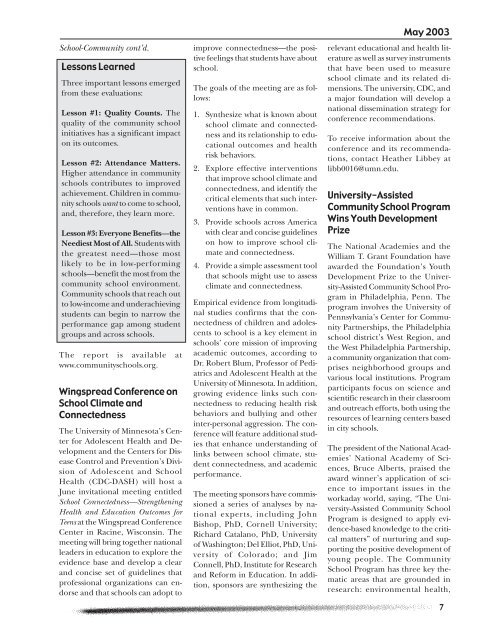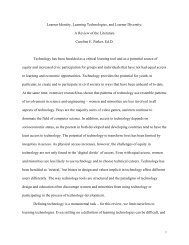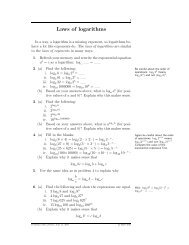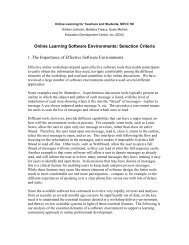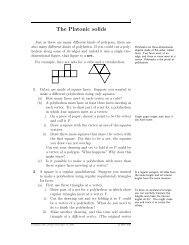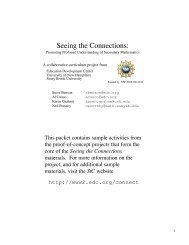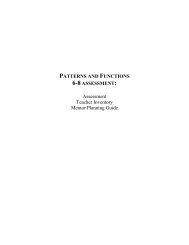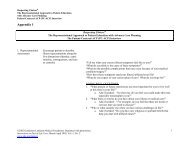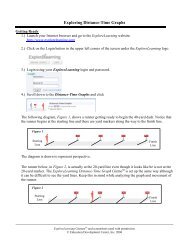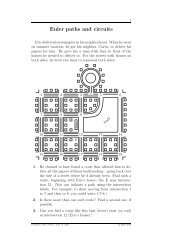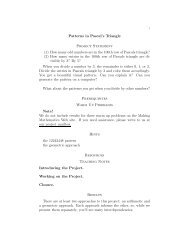School Health Program News - Education Development Center
School Health Program News - Education Development Center
School Health Program News - Education Development Center
Create successful ePaper yourself
Turn your PDF publications into a flip-book with our unique Google optimized e-Paper software.
<strong>School</strong>-Community cont’d.Lessons LearnedThree important lessons emergedfrom these evaluations:Lesson #1: Quality Counts. Thequality of the community schoolinitiatives has a significant impacton its outcomes.Lesson #2: Attendance Matters.Higher attendance in communityschools contributes to improvedachievement. Children in communityschools want to come to school,and, therefore, they learn more.Lesson #3: Everyone Benefits—theNeediest Most of All. Students withthe greatest need—those mostlikely to be in low-performingschools—benefit the most from thecommunity school environment.Community schools that reach outto low-income and underachievingstudents can begin to narrow theperformance gap among studentgroups and across schools.The report is available atwww.communityschools.org.Wingspread Conference on<strong>School</strong> Climate andConnectednessThe University of Minnesota’s <strong>Center</strong>for Adolescent <strong>Health</strong> and <strong>Development</strong>and the <strong>Center</strong>s for DiseaseControl and Prevention’s Divisionof Adolescent and <strong>School</strong><strong>Health</strong> (CDC-DASH) will host aJune invitational meeting entitled<strong>School</strong> Connectedness—Strengthening<strong>Health</strong> and <strong>Education</strong> Outcomes forTeens at the Wingspread Conference<strong>Center</strong> in Racine, Wisconsin. Themeeting will bring together nationalleaders in education to explore theevidence base and develop a clearand concise set of guidelines thatprofessional organizations can endorseand that schools can adopt toimprove connectedness—the positivefeelings that students have aboutschool.The goals of the meeting are as follows:1. Synthesize what is known aboutschool climate and connectednessand its relationship to educationaloutcomes and healthrisk behaviors.2. Explore effective interventionsthat improve school climate andconnectedness, and identify thecritical elements that such interventionshave in common.3. Provide schools across Americawith clear and concise guidelineson how to improve school climateand connectedness.4. Provide a simple assessment toolthat schools might use to assessclimate and connectedness.Empirical evidence from longitudinalstudies confirms that the connectednessof children and adolescentsto school is a key element inschools’ core mission of improvingacademic outcomes, according toDr. Robert Blum, Professor of Pediatricsand Adolescent <strong>Health</strong> at theUniversity of Minnesota. In addition,growing evidence links such connectednessto reducing health riskbehaviors and bullying and otherinter-personal aggression. The conferencewill feature additional studiesthat enhance understanding oflinks between school climate, studentconnectedness, and academicperformance.The meeting sponsors have commissioneda series of analyses by nationalexperts, including JohnBishop, PhD, Cornell University;Richard Catalano, PhD, Universityof Washington; Del Elliot, PhD, Universityof Colorado; and JimConnell, PhD, Institute for Researchand Reform in <strong>Education</strong>. In addition,sponsors are synthesizing theMay 2003relevant educational and health literatureas well as survey instrumentsthat have been used to measureschool climate and its related dimensions.The university, CDC, anda major foundation will develop anational dissemination strategy forconference recommendations.To receive information about theconference and its recommendations,contact Heather Libbey atlibb0016@umn.edu.University-AssistedCommunity <strong>School</strong> <strong>Program</strong>Wins Youth <strong>Development</strong>PrizeThe National Academies and theWilliam T. Grant Foundation haveawarded the Foundation’s Youth<strong>Development</strong> Prize to the University-AssistedCommunity <strong>School</strong> <strong>Program</strong>in Philadelphia, Penn. Theprogram involves the University ofPennsylvania’s <strong>Center</strong> for CommunityPartnerships, the Philadelphiaschool district’s West Region, andthe West Philadelphia Partnership,a community organization that comprisesneighborhood groups andvarious local institutions. <strong>Program</strong>participants focus on science andscientific research in their classroomand outreach efforts, both using theresources of learning centers basedin city schools.The president of the National Academies’National Academy of Sciences,Bruce Alberts, praised theaward winner’s application of scienceto important issues in theworkaday world, saying, “The University-AssistedCommunity <strong>School</strong><strong>Program</strong> is designed to apply evidence-basedknowledge to the criticalmatters” of nurturing and supportingthe positive development ofyoung people. The Community<strong>School</strong> <strong>Program</strong> has three key thematicareas that are grounded inresearch: environmental health,7


